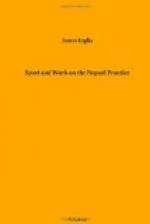On the way home we bagged a florican and a very fine mallard, and reached the camp utterly fagged, to find our worthy magistrate very much recovered, and glad to congratulate us on our having bagged the tigress. After a plunge in the river, and a rare camp dinner—such a meal as only an Indian sportsman can procure—we lay back in our cane chairs, and while the fragrant smoke from the mild Manilla curled lovingly about the roof of the tent, we discussed the day’s proceedings, and fought our battles over again.
A rather animated discussion arose about the length of the tiger—as to its frame merely, and we wondered what difference the skin would make in the length of the animal. As it was a point we had never heard mooted before, we determined to see for ourselves. We accordingly went out into the beautiful moonlight, and superintended the skinning of the tigress. The skin was taken off most artistically. We had carefully measured the animal before skinning. She was exactly nine feet long. We found the skin made a difference of only four inches, the bare skeleton from tip of nose to extreme point of tail measuring eight feet eight inches.
As an instance of tigers taking to trees, our worthy magistrate related that in Rajmehal he and a friend had wounded a tiger, and subsequently lost him in the jungle. In vain they searched in every conceivable direction, but could find no trace of him. They were about giving up in despair, when S., raising his hat, happened to look up, and there, on a large bough directly overhead, he saw the wounded tiger lying extended at full length, some eighteen feet from the ground. They were not long in leaving the dangerous vicinity, and it was not long either ere a well-directed shot brought the tiger down from his elevated perch.
These after-dinner stories are not the least enjoyable part of a tiger-hunting party. Round the camp table in a snug, well-lighted tent, with all the ‘materials’ handy, I have listened to many a tale of thrilling adventure. S. was full of reminiscences, and having seen a deal of tiger shooting in various parts of India, his recollections were much appreciated. To shew that the principal danger in tiger shooting is not from the tiger himself, but from one’s elephant becoming panic-stricken and bolting, he told how a Mr. Aubert, a Benares planter, lost his life. A tiger had been ‘spined’ by a shot, and the line gathered round the prostrate monster to watch its death-struggle. The elephant on which the unfortunate planter sat got demoralised and attempted to bolt. The mahout endeavoured to check its rush, and in desperation the elephant charged straight down, close past the tiger, which lay writhing and roaring under a huge overhanging tree. The elephant was rushing directly under this tree, and a large branch would have swept howdah and everything it contained clean off the elephant’s back, as easily as one would brush off a fly. To save himself Aubert




